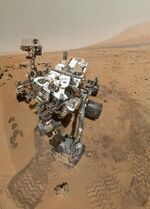Astronomy:BD+48 740
| Observation data Equinox J2000.0]] (ICRS) | |
|---|---|
| Constellation | Perseus |
| Right ascension | 02h 42m 58.21780s[1] |
| Declination | +48° 55′ 48.2155″[1] |
| Characteristics | |
| Spectral type | K3III[2] |
| Astrometry | |
| Radial velocity (Rv) | -5.60 ± 0.51[3] km/s |
| Proper motion (μ) | RA: -5.94[1] mas/yr Dec.: -2.02[1] mas/yr |
| Parallax (π) | 1.36 ± 1.13[1] mas |
| Distance | approx. 2,000 ly (approx. 700 pc) |
| Details[4] | |
| Mass | 1.09±0.16 M☉ |
| Radius | 10.33±1.81 R☉ |
| Luminosity | 43.7 L☉ |
| Surface gravity (log g) | 2.48±0.04 cgs |
| Temperature | 4534±8 K |
| Metallicity [Fe/H] | -0.13±0.06 dex |
| Rotational velocity (v sin i) | <2.9 km/s |
| Other designations | |
| Database references | |
| SIMBAD | data |
BD+48 740 is a giant star suspected of having recently engulfed one of its planets. The star's atmosphere has an overabundance of lithium, a metal that is destroyed by nuclear reactions in stars.
Planetary system
Detection of variations in the star's radial velocity led to the discovery of the superjovian planet BD+48 740 b in 2012,[5] with the discovery having been confirmed in 2018.[4] The planet BD+48 740 b has a minimal mass of 1.7MJ and is in a highly eccentric orbit (its distance from the star ranges from 0.3 to 3 astronomical units), which would destabilize the orbits of any other planets. These indications led the discoverers to the conclusion that another planet has recently plunged into the star, been destroyed, and contributed its lithium content to the star.[5]
| Companion (in order from star) |
Mass | Semimajor axis (AU) |
Orbital period (days) |
Eccentricity | Inclination | Radius |
|---|---|---|---|---|---|---|
| b | >1.7±0.7 MJ | 1.7±0.1 | 733+5−8 | 0.76+0.05−0.09 | — | — |
References
- ↑ 1.0 1.1 1.2 1.3 1.4 van Leeuwen, F. (2007). "Validation of the new Hipparcos reduction". Astronomy and Astrophysics 474 (2): 653–664. doi:10.1051/0004-6361:20078357. Bibcode: 2007A&A...474..653V. http://www.aanda.org/index.php?option=com_article&access=bibcode&Itemid=129&bibcode=2007A%2526A...474..653VFUL.
- ↑ 2.0 2.1 "BD+48 740". SIMBAD. Centre de données astronomiques de Strasbourg. http://simbad.u-strasbg.fr/simbad/sim-basic?Ident=BD%2B48+740.
- ↑ Famaey, B.; Jorissen, A.; Luri, X.; Mayor, M.; Udry, S.; Dejonghe, H.; Turon, C. (2005). "Local kinematics of K and M giants from CORAVEL/Hipparcos/Tycho-2 data. Revisiting the concept of superclusters". Astronomy and Astrophysics 430: 165. doi:10.1051/0004-6361:20041272. Bibcode: 2005A&A...430..165F.
- ↑ 4.0 4.1 4.2 Adamów, M.; Niedzielski, A.; Kowalik, K.; Villaver, E.; Wolszczan, A.; MacIejewski, G.; Gromadzki, M. (2018), "Tracking Advanced Planetary Systems (TAPAS) with HARPS-N", Astronomy & Astrophysics 613: A47, doi:10.1051/0004-6361/201732161
- ↑ 5.0 5.1 Adamów, M.; Niedzielski, A.; Villaver, E.; Nowak, G.; Wolszczan, A. (2012). "BD+48 740—Li Overabundant Giant Star with a Planet: A Case of Recent Engulfment?". The Astrophysical Journal 754 (1): L15. doi:10.1088/2041-8205/754/1/L15. Bibcode: 2012ApJ...754L..15A.
External links
- Adamów, M.; Niedzielski, A.; Villaver, E.; Nowak, G.; Wolszczan, A. (2012). "BD+48 740—Li OVERABUNDANT GIANT STAR WITH a PLANET: A CASE OF RECENT ENGULFMENT?". The Astrophysical Journal 754 (1): L15. doi:10.1088/2041-8205/754/1/L15. Bibcode: 2012ApJ...754L..15A.
 |



